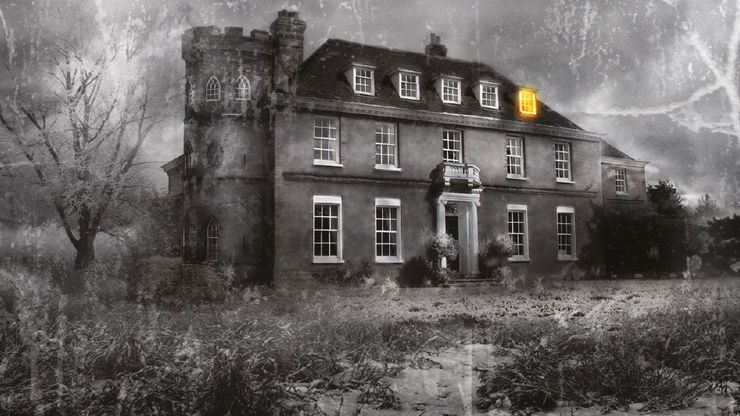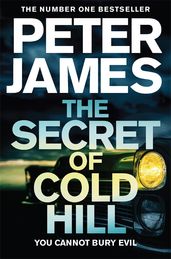The Grey Lady: the story behind The House on Cold Hill
Sometimes truth is stranger than fiction. Here, Peter James tells the story of the spooky encounters that inspired him to write his chilling novel The House on Cold Hill.

Many readers like to give themselves the chills with a horrifying ghost story or nail-biting horror novel, safe in the knowledge that when they put the book down and turn off the lights, they’re going to sleep in the rational world. But what if you knew the ghost story you were reading was inspired by the author’s own terrifying real-life experiences? Here, Peter James, author of the spine-chilling novels The House on Cold Hill and The Secret of Cold Hill, tells us about the spooky real-life experiences that inspired the books.
The House On Cold Hill is very much inspired by, and modelled on, an isolated historic house in Sussex that my former wife and I bought in 1989 – and which turned out to be seriously haunted.
It was a classically beautiful, rather melancholic looking Georgian manor house on the edge of a Sussex hamlet, with a long history. Before being a manor house in the middle ages it had been a monastery, and prior to that there had been a Roman villa on the site.
‘You'll like this house, with what you write,’ the owner told me mischievously on our first viewing. 'We have three ghosts.’ It turned out he was fibbing – the house, we were to discover later, actually had four . . .
The first one manifested while we were in the process of moving in. I was standing in the front porch, on a beautiful spring morning, with my mother-in-law, a very down-to-earth lady who was a senior magistrate. But she had a 'fey' side to her – in that she was very open-minded about the paranormal, and always had a particular recurring, frightening dream whenever someone she knew was about to die.From the front door where we were standing, there was a long, narrow corridor which ran almost the width of the house, through to an oak-panelled atrium, with four Doric columns, which led through into the kitchen. This atrium was all that remained of the monastery which had originally been on the site, and you could still see the arches where the altar had been.
As we stepped aside to let the removals men leave the house to fetch another item, I suddenly saw a shadow, like the flit of a bird across a fanlight, in the interior of the house.
'Did you see that?' she asked, with a knowing look.
Despite the warmth of the sunlight, I felt a sudden chill. I knew at that moment she had seen something uncanny. But I did not want to spook my wife on our very first day in this house. We were both townies, and this was our first move into the countryside. She was already apprehensive about the isolation of the property. The last thing I needed was for her to be unnecessarily scared by a ghost. So I shook my head and told her I had not seen anything. But in truth, I was feeling a little spooked.
Our first night was uneventful, and our Hungarian Puli dog had been happy and calm. I’d been told that dogs would often pick up on any supernatural occurrence way before their owners, so I took this as a good sign.
In the morning, my wife left for work at 8am. After breakfast I went to my study to resume work on my third supernatural novel, Sweet Heart. Around 10.30am I went downstairs to make a cup of coffee. As I entered the atrium, on my way through to the kitchen, I saw tiny pinpricks of white light all around me. My immediate reaction was that it was sunlight, coming through the window in the far wall, reflecting off my glasses. I took them off, put them back on, and the pinpricks of light had gone.
I returned to my study, but when I went downstairs to make myself some lunch, the same thing happened. And again after removing my glasses and putting them back on again, the pinpricks had gone. But I was left with a slightly uneasy feeling. In the afternoon, when I went downstairs to make a mug of tea, it happened again.
I said nothing to my wife when she arrived home that evening, and she did not see anything.
The next day around mid morning, when I was alone in the house, I saw the pinpricks again, and at lunchtime. After lunch I took the dog for a walk. We’d only gone a short distance along the lane when an elderly man came up to me, introducing himself as a neighbour in the hamlet.
‘You are Mr James, aren’t you?’ he asked.
‘Yes, I am,’ I replied.
‘You've just moved into the Manor?’
‘Two days ago.’
‘How are you getting on with your grey lady?’ he said, with a strange, quizzical look that immediately unsettled me.
‘What grey lady?’ I asked.
He then really spooked me. ‘I was the house sitter for the previous owners. In winter, they used the atrium as a ‘snug’ because, adjoining the kitchen, it was always warm from the Aga. Six years ago I was sitting in the snug, watching television, when a sinister looking woman, her face grey, and wearing a grey, silk crinoline dress, materialized out of the altar wall, swept across the room, gave me a malevolent stare, gave my face a flick with her dress, and vanished into the paneling behind me. I was out of there thirty seconds later, and went back in the morning to collect my things. Wild horses wouldn’t drag me back in there again!’
I was struck both by the sincerity of the man, and his genuine fear, which I could see in his eyes as he told me the story. It truly made the hairs on the back of my neck rise.
I returned to the house after our walk, feeling very uncomfortable. I even wimped out of going through the atrium into the kitchen to make my afternoon cuppa. But when my wife came home in the evening, I said nothing – I suppose I did not want to believe it myself, and she was still extremely nervous about living in such an isolated house.
The following Sunday, we invited her parents to lunch. Whilst she was occupied putting the finishing touches to the meal, I took her mother aside and asked her what exactly she had seen that day we were moving in. She described a woman, with a grey face, dressedin grey silk crinoline, moving across the atrium – exactly what the old man had described to me.
I was stunned – and very spooked. Later, after her parents had left, I decided I had to tell my wife. She took it in the pragmatic way she had of dealing with most difficult issues in life. ‘You’ve met several mediums in your research – why don’t you ask one of them to come in and see what they find?’
A few days later, a medium who had helped me a lot during my writing of Possession came to the house, and I took her into the atrium, and left her on her own, as she had requested.
An hour later she came up to my study, and yet again, described exactly this woman in grey silk crinoline. She explained the pinpricks of light I kept seeing by telling me I was slightly psychic, so while I was not actually seeing the entire apparition, I was picking up some of its energy – hence the pinpricks of light.
I asked her if there was anything I could do about this, and she told me that the apparition was of a deeply disturbed former resident of the house, and that it needed a clergyman to deal with it.
I felt a tad cynical about her response – but at the same time, I was now feeling deeply uncomfortable in what should have been the sanctuary of my own home. But there was a vicar I knew who I thought would be able to help, and with whom I had become good friends.
At the time he was officially the Vicar of Brighton – but with another hat, he was also officially, the Chief Exorcist of the Church Of England. That wasn’t his actual title, which was the less flaky-sounding ‘Minister Of Deliverance.’ A former monk, the son of two medics, a university double first in psychology, he was as far from Max Von Sydow’s Father Merrin in The Exorcist as you could get. He is a delightful human being, with whom I had become good friends, and still am to this day. He is a modern thinker, a clergyman who has a problem with the biblical concepts of God, yet still retains an infectious faith. His views, for instance, on the Ouija board are, that far from putting its participants in touch with the spiritual world, it actually opens up a Pandora’s Box of their own inner demons.
Even so, I was a little surprised when he cheerfully entered the atrium, stood still for a couple of minutes, and then loudly and very firmly enunciated, into thin air, ‘You may go now!’
He turned to me and said, ‘You should be fine now.’
The above story was only one of the spooky occurrences we had in this otherwise glorious house.
As a postscript, I should add something of the house’s history. For much of the 20th Century it was owned by the Stobart family, the most famous member of which, Tom Stobart OBE, was a photographer, zoologist and author. A true adventurer, he was the cameraman who climbed Everest with Hunt and Hillary and took the photos of their ascent, subsequently was shot in the knee in Ethiopia, and tragically died far too young from a heart attack at the local railway station, Hassocks. One member of the family was, reputedly, a strange lady, who subjected Tom’s sister Anne, who we befriended in the years before she died from a stroke, to such cruelty as a child she was never able to live a normal life, or form normal relationships.
Was she the grey lady in the atrium?
During the Second World War, the house was used to billet Canadian soldiers. After the War, during the second half of the twentieth century, three couples bought it – and all subsequently divorced. We were the third. Was the Grey Lady in any way responsible?
I will always wonder.
The House on Cold Hill
by Peter James
The House on Cold Hill is a chilling ghost story full of suspense. The Harcourts decide to make a big life change, moving from th entre of Brighton to an old Georgian mansion in the depths of the Sussex countryside. Ollie is sure this is the right move for his family, but his wife and twelve-year-old daughter aren’t convinced. And within days of moving in, it’s clear that the Harcourts aren’t the only residents of the house . . .
The Secret of Cold Hill
by Peter James
Cold Hill House was burned to the ground, and with it, all the terrible memories of the house’s violent history went up in smoke. Now an ultra-modern housing development has been built on the site, and despite the ongoing construction work, the first two families to move in are certain they’ve found their dream homes. But there was one thing the estate agents didn’t mention; nobody in Cold Hill House ever survived beyond forty . . .




